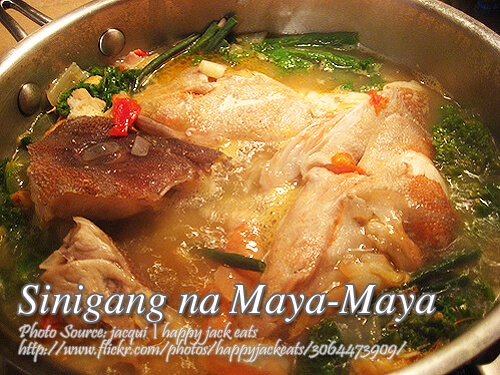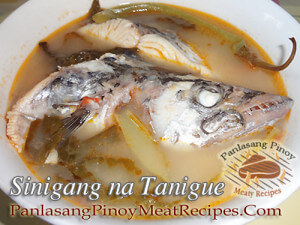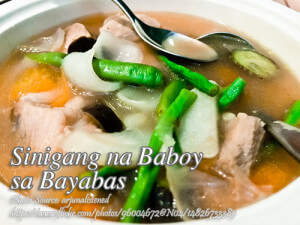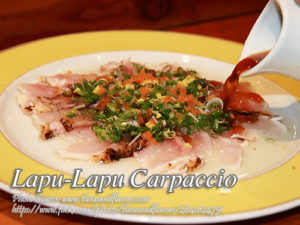This recipe is red snapper or maya-maya cooked in sour broth made from tomatoes, onions, green mango strips, radish and kangkong. Unlike the usual sinigang, which uses tamarind fruits or kamias (ginger lily) to give that sourness taste on the sour broth, this sinigang use unripe green mango. Try this unique fish sinigang dish and I’m sure you will like it.
Sinigang na Maya-Maya: A Taste of Nostalgia with a Twist
Growing up in a big Filipino family, Sundays are always the most-awaited day of the week. It’s when everyone gathered at my Lola’s house, bringing their favorite dishes to share. Among the many specialties gracing the dining table, one dish stood out for its simplicity and comforting flavors-fish sinigang. My Lola would always get the freshest catch in the local market, and while the tamarind was what she often used for souring, my Uncle Boyong, who used to be stationed here in Cavite-which is just one town away from the coastal town of Nasugbu-said we should use green mangoes instead. It gave the soup this unique tang that instantly harked back to summer holidays spent by the beach.
This sinigang recipe uses maya-maya, or red snapper, and the broth here is not quite your usual sour soup. What makes this dish is a green mango that refreshes with its tart flavor without overpowering the subtlety of fish. In this sinigang, play brings about a balance warming the heart and renewing at the same time—at a rainy afternoon or just if you crave something warm inside.
The Sinigang Secret
My Aunties taught me over the years that even without their power to really taste the meat, the pasta, or the fried foods, sinigang has much more to do with the broth. And no, it’s not all about dumping all the ingredients into a pot and leaving it for chance. According to my Tita Nena, who has been cooking since decades ago, it is all about the trick of timing and patience. She was fussy about sautéing onions and tomatoes, before anything else, coaxed out the natural sweetness from it, thus setting the base for a strong, juicy broth.
But it is in that combination of green mango strips when added to sautéed onions and tomatoes wherein the magic really happens. Mangoes were green and still firm with a tad bit of sourness, but slowly released that sour taste within the broth, giving it that special zing that separated it from any other tamarind-based soup. And while the rice washing sounds very simplistic to add, I swear by this old trick my Lola would say, gives soup this subtle thickness that everything goes together.
Preparing with Maya-Maya: Why Red Snapper is the Star
One of the prestige fishes in Filipino cooking is red snapper, or maya-maya, for it does not only possess a mild, sweet flavor but its firm texture also stands well in soups. I remember my cousin Jomar telling me that he once was a fisherman, and there is really nothing to compare with a maya-maya in cooking sinigang. It absorbs the flavors of the broth well without breaking.
Now, if you have never cooked using maya-maya before, don’t worry-it’s quite forgiving. You can fry it until golden, then put it into the broth, or you just slip it gently into the soup and cook-they always come out delicious. Some like to fry the fish first, and my mom, for example, was into that. She adds that it gives fish an extra layer of texture and flavor, though personally, I like it poached. The tender flesh of the fish soaks up all the tangy and savory goodness of the broth, and every bite reminds me of those lazy afternoons we spent in the province, where life was slowed down to a snail’s pace, and food was always freshly caught.
Twist: Souring Agent is with Green Mangoes
Although tamarind is more typical and traditional for sinigang, green mango makes a refreshing turn of events for the dish. It does not have a sour taste like that of tamarind, but it has a fruity undertone to it that will complement well the delicate flavor of fish. My brother, Rey, who was studying culinary arts in Manila, told me one time that green mango is used especially in the more tropical areas of the Philippines where tamarind is not readily available.
This method of using mango for soups may have originated from my Lola’s Visayan hometown. She recalls vividly how her mother prepared fish soup with whatever fruits were near, and unripe mangoes were aplenty at some periods of the year. The outcome is a soup that’s not too sour but rather one with balanced, rich flavors all thanks to the fruit and vegetables’ union.
With the Dish: The Perfect Dip
This dish is incomplete without an excellent dip, and no Filipino meal is ever complete without one. Simple defines this marinade concoction: calamansi zest, Lea & Perrins Worcestershire sauce, and patis or fish sauce. This zingy salty dip brings forth the best of the snapper and lets out the real sweetness of the fish through a flavor burst. My father always included some chopped chilies in his dipping sauce to give it a bit of kick and, ever since then, I have been doing the same.
A Bowl of Nostalgia Down Comfort
Every time I cook this, I go back to those lazy Sundays with the family when we would sit around the table laughing and sharing stories in bowls of steamy sinigang. There is just something about the whole combination of fish, sour broth, and fresh vegetables that just gives one a feel of being at home. Whether you are an experienced cook or just starting to learn, this dish surely deserves a try. It’s so easy to make, besides bringing into your own kitchen that Filipino tradition.
I hope you enjoy this fresh take on a favorite, as much as my family and I have enjoyed it over the years.
How to Cook Sinigang na Maya-Maya (Red Snapper In Sour Broth)
Ingredients
- 200 grams fresh red snapper {Maya-Maya)
- 1 medium-sized unripe green mango
- 1 cup stringbeans cut into 3-inch long pieces
- 6 cups rice washing hugas bigas
- 1 piece peeled and sliced radish labanos
- 2 cups kangkong leaves selecting with tender stalks
- 1 pc sliced large onion
- 4 pcs chopped tomatoes
- Lea & Perrins Worcestershire Sauce
- calamansi zest
- salt or fish sauce, to taste patis
Instructions
How to cook Sinigang na Maya-Maya
- Wash and cut kangkong leaves. Peel and seed mango and cut into large strips.
- Set kangkong and mango strips aside. To make sour broth, saute onion then add tomatoes and mango strips.
- Cook until tender then add rice washing and bring to a boil.
- Add fish to sour broth mixture. Simmer and season with salt and Lea & Perrins Worcestershire Sauce.
- Add vegetables while continuing to simmer broth mixture in low heat.
- Cover for a few minutes or just when fish is cooked and vegetables are soft but not mushy.
- Mix calamansi zest, Lea & Perrins Worcestershire Sauce and patis to serve as dipping sauce for the fish.
- As an option, fry fish until golden brown before adding to the sour broth. Serves 1-2.
Notes
Cooking Tips:
Choose Fresh Maya-Maya for Best Results
Ideally, this dish will taste fantastic and soft if fresh maya-maya or red snapper is utilized. While choosing the fish for use, consider those with clear eyes, bright red gills, and firm flesh. The fish would then remain soft and able to absorb the tart broth well without breaking apart.Sauté Tomatoes and Onions for a More Flavourful Broth
Sauteing the onions and tomatoes first before adding the other ingredients deepens the flavor of the broth. This is because such a step releases the natural sweetness in the vegetables, thus balancing the sourness of the green mango. Be patient and let the vegetables become soft completely before tasting the soup.Heat Control When Cooking Fish
Let it simmer on low heat so that it doesn't get overcooked and breaks apart. Red snapper is a delicate fish, and boiling should be n't hot; instead, let it poach slowly in the broth to absorb tangy flavors and savory without letting it go for a total texture destroyer.






Thanks for your recipe! I’ve been craving for this sinigang a long time a go.
Hi Jenny, thanks also for leaving your comment!